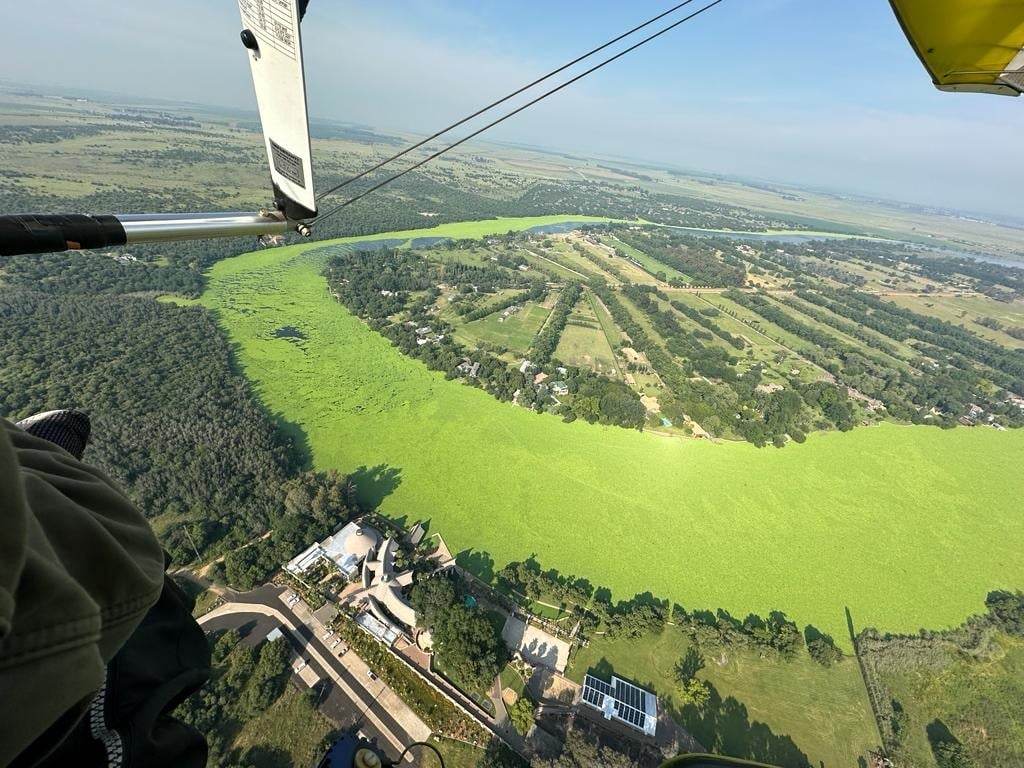
In 2021, water lettuce had never been heard of in the Vaal. Three years later, it has totally dominated the system, writes Anthony Turton.
In my lifetime, South Africa transitioned from a mining and agricultural economy, to an industrialised one. This process made South Africa the only African country with a manufacturing component to it.
The epicentre of this process was undoubtedly what became known as the Pretoria Witwatersrand Vereeniging (PWV) Triangle. There was more capital investment into manufacturing in that relatively small area of maybe 20 000 square kilometers, than the rest of Africa combined.
At the heart of this process was a simple thing that we can call ingenuity. A Canadian author, philosopher and academic named Thomas Homer-Dixon devoted considerable energy to understanding this phenomenon.
During the 1990s, there was a lot of interest in the role of environmental scarcities and violent conflict, and his team played a central role in this. In 1996, he published a paper with the American Association for the Advancement of Science, in which he answered the question about why poor countries remain poor and rich countries continue to get richer.
A diversified industrial economy
At that time, South Africa had just negotiated a peaceful transition to democracy, and so our paths crossed in a professional sense when he was publishing on the linkage between the environment and conflict, most notably when he documented the South African case in 1994. The simple answer to the question that he addressed in 1996 was subsequently published in his seminal book entitled Ingenuity in 2000.
What Homer-Dixon did was accurately provide a model that could explain how South Africa became a diversified economy in Africa. We bucked the trend identified in his 1996 work when we successfully managed to solve the problem of wealth creation through diversification, mostly through parastatal bodies like ISCOR, ESCOM, SASOL and others. This was concentrated in the PWV Triangle, through which the Vaal River flowed.
By creating a sophisticated policy environment supported by institutions that were fit for purpose, South Africa transitioned away from an extractive economy, typical of most African states today, to a diversified industrial economy, eventually producing products like cables, chains, specialised steels, pumps and motorcars.
Water played a key role in this transition. In the Eastern Cape, it was water diverted from the Orange River to the city of what was then known as Port Elizabeth that became the foundation of an export-oriented motor manufacturing industry.
In the Witwatersrand Goldfields, it was Rand Water that was tasked in 1903 to create the hydraulic foundation for the national economy that would grow from the back of mining. To accomplish these feats of modernity, a national hydraulic mission was needed.
Pumping uphill
This was triggered by the loss of investor confidence after Sharpeville when the Commission of Inquiry into Water Matters was launched. A direct result of that commission was what can best be described as three decades of heroic engineering, that pumped water uphill against the force of gravity.
Nowhere was this more evident than in the PWV Triangle, where three major metros eventually flourished – Johannesburg, Ekurhuleni, and Tshwane – along with many smaller cities like Springs in the east and Randfontein in the west.
By mobilising masses of ingenuity, the national economy grew rapidly as industrialisation created jobs simply not available in a mining and agricultural economy. This validates Homer-Dixons model, so let us return to it once again to figure out what is likely to happen soon.
Homer-Dixon notes that ingenuity becomes a treadmill because the more that is mobilised, the more it must be mobilised simply to stay ahead of the curve. He refers to the classic work by Edward Tenner, published in 1996, while Homer-Dixon was working on the question of why poor countries remain poor. Tenner wrote a classic entitled Why Things Bite Back: Technology and the Revenge of Unintended Consequences.
Applying this to the three decades of heroic engineering from the 1970s to the 1990s, we can see that rivers were connected to create water security on which investor confidence would grow. This meant that human migration followed, and jobs were created in what is now known as Gauteng.
In fact, a third of all South African citizens now work in Gauteng, which also generates about two-thirds of our total economic output. What happens in Gauteng is a big deal. By implication, what happens in the Vaal River, on which a third of all citizens and two-thirds of the total economy is dependent, is also a big deal.
An order of maginitude
Now let's try to equate the ingenuity on which these people depend to some numbers that can give us a sense of size. Here we are interested in abstract numbers, expressed in orders of magnitude, rather than actual numbers.
For the sake of our argument, we can say that around 20 000 engineers have worked in various roles to transfer water from the Vaal into the PWV Triangle, on which 20 000 000 people are dependent.
Here the order of magnitude matters, so let me explain. An order of magnitude is when an additional zero is added. Therefore 100 is one order of magnitude bigger than 10. This means that 20 000 000 (the number of citizens dependent on water from the Vaal) is three orders of magnitude bigger than 20 000 (the number of engineers who created the water security in the first place).
Homer-Dixon tells us that the level of ingenuity needed to solve a problem exceeds the level of ingenuity that created the problem in the first place. This is central to Tenner’s notion of the revenge effect when unintended consequences become manifest. Therefore, using pure logic, we can conclude that we would need to mobilise ingenuity greater than the 20 000 engineers who created water security simply to overcome the problem created by the migration triggered by their heroic engineering.
This is important because those 20 million people each produce about 200 litres of waste daily, which equates to 4 billion litres of sewage. This flows by gravity into the very rivers from which their drinking water is obtained.
This is our problem.
Water lettuce dominates the system
In 2021, water lettuce had never been heard of in the Vaal. Three years later, it has totally dominated the system. The rate of change is impressive. What took 50 years to occur in Hartbeespoort Dam, took three years to occur in the Vaal. That’s an order of magnitude difference.
Change is happening at a speed one order of magnitude faster than we are familiar with, which implies that we would logically need more ingenuity than the 20 000 engineers that created the problem in the first place. We are then shocked to find that the total ingenuity we are allocating to the solution is less than 20 people, which is three orders of magnitude less than the minimum we require if we believe Homer-Dixon.
Let’s put this into perspective. We now expect a technical task team of 20 people, to solve the problem created by 20 000 specialists, which is moving an order of magnitude faster, to save 20 million people and two-thirds of our national economy.
Now we can revisit Homer-Dixons' work from 1996, in which he noted that poor countries get poorer because they are unable to mobilise the ingenuity that rich countries use to get richer. We see this playing out before our very eyes.
A logical conclusion to this is that unless we start to collectively realise just how close we are to a national catastrophe of unprecedented proportions, the sooner that calamity will be upon us.
In a successful economy, technically savvy people collectively unite to solve complex problems. As things currently stand, we are not even in the ballpark, which is why, in three years, the Vaal has become as bad as Hartbeespoort took 50 years to become.
Unless those 20 lonely specialists can perform scientific miracles in a few months, that exceed the heroic engineering created by the 20 000, over three decades, then we are in for a rude awakening as we discover why poor countries simply get poorer while rich countries continue to thrive.
Have you ever seen a treadmill throw off a runner that is unable to match the speed? This is what will happen to the 20 million who are now totally dependent on the ingenuity of the 20. That’s six orders of magnitude differnce.
Time to take a bite of the reality sandwich. Our water crisis is becoming real.
- Dr Anthony Turton is with the Center for Environmental Management University of Free State.
Disclaimer: News24 encourages freedom of speech and the expression of diverse views. The views of columnists published on News24 are therefore their own and do not necessarily represent the views of News24.




 Publications
Publications
 Partners
Partners























